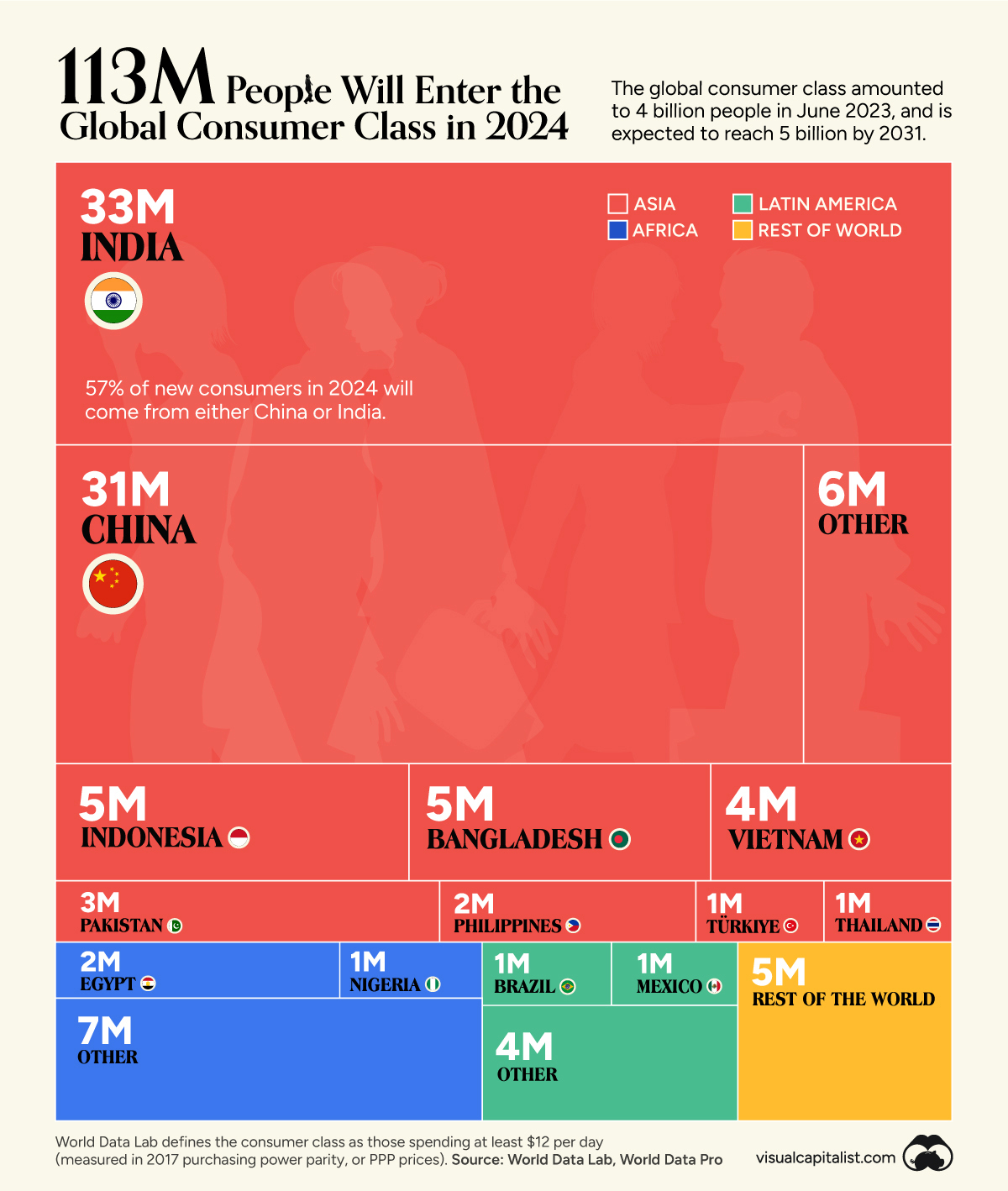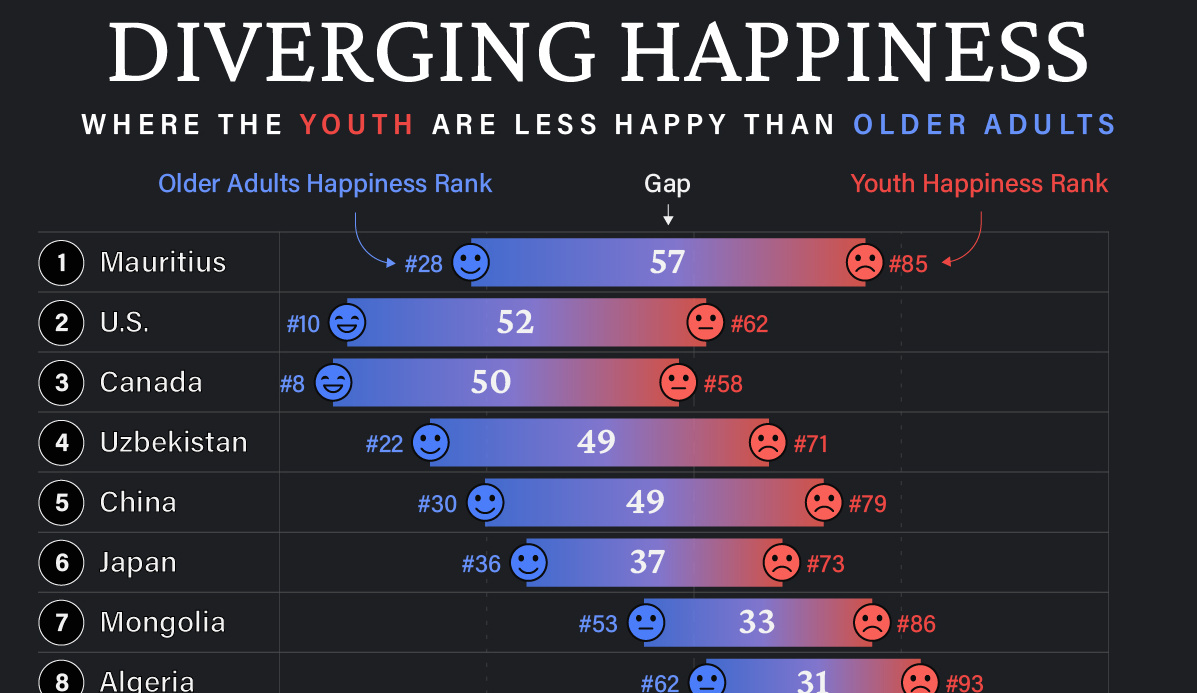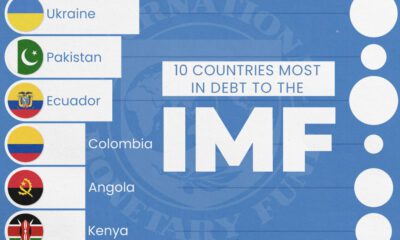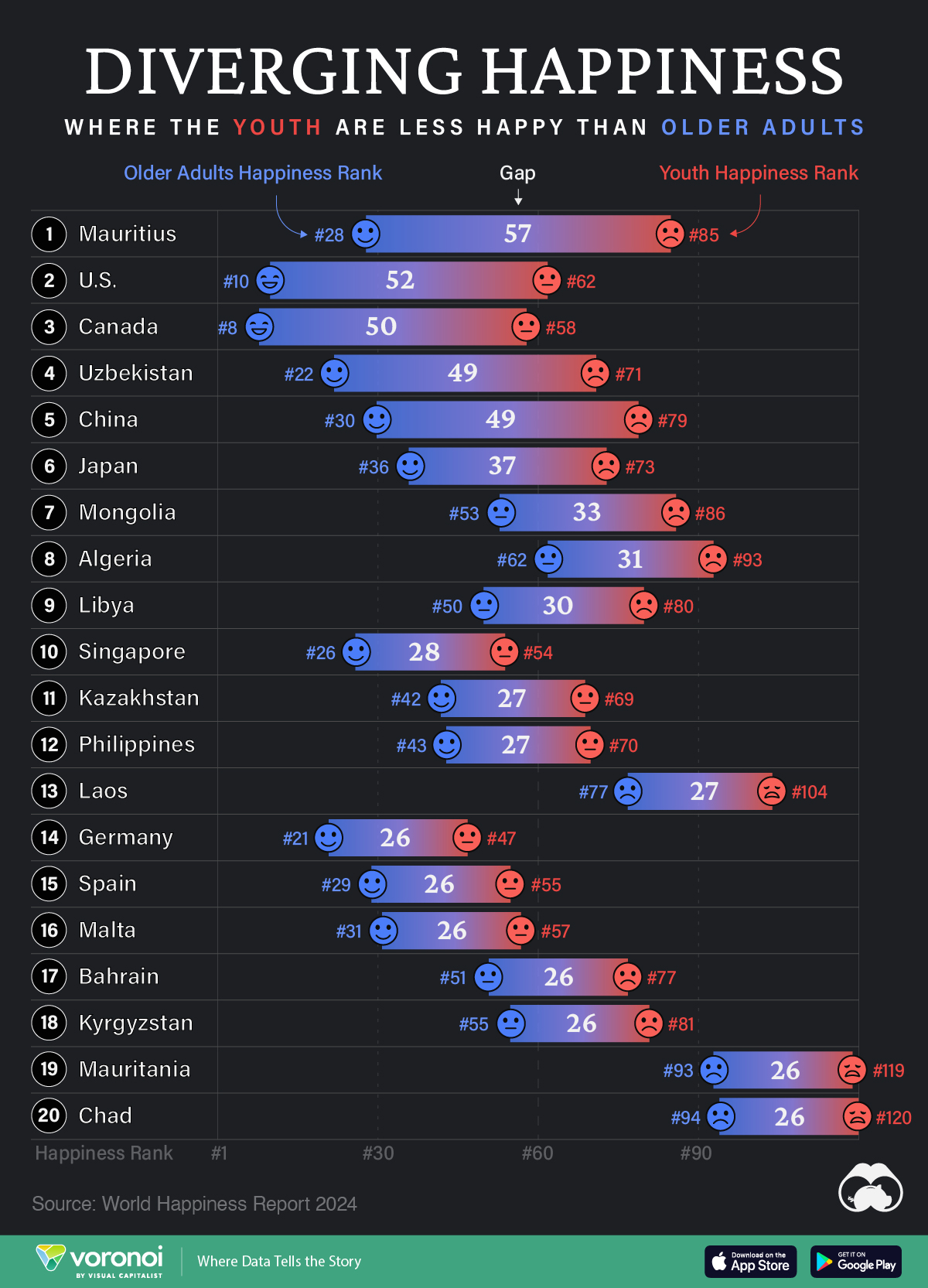Demographics
113 Million People Will Join the Global Middle Class in 2024

113 Million People Will Join the Global Middle Class in 2024
Every year, over 100 million people enter the global middle class.
Defined by the World Data Lab as someone who spends at least $12 per day (measured in 2017 purchasing power parity), these individuals are typically rising up in developing regions like Asia and Africa.
In this graphic, we’ve created a treemap diagram that shows where the new entrants to this consumer class in 2024 will originate from.
Where are Millions of New Consumers Coming From?
World Data Lab expects 113 million people to join the global middle class in 2024, with the vast majority coming from Asia.
The following table includes the data we used to create this graphic, at a regional level (figures rounded).
| Region | New Consumers (millions) |
|---|---|
| 🌏 Asia | 91 |
| 🌍 Africa | 10 |
| 🌎 Latin America | 6 |
| 🗺️ Rest of World | 5 |
Based on these figures, we can conclude that Asia will contribute 81% of new consumers in 2024.
Highlights from Asia
The following table breaks down Asia’s 91 million new consumers for 2024, by country. Note that only countries which contribute at least 1 million consumers were broken out, with the rest grouped into “Other”.
| Country | New Consumers (millions) |
|---|---|
| 🇨🇳 China | 31 |
| 🇮🇳 India | 33 |
| 🇮🇩 Indonesia | 5 |
| 🇧🇩 Bangladesh | 5 |
| 🇻🇳 Vietnam | 4 |
| 🇵🇰 Pakistan | 3 |
| 🇵🇭 Philippines | 2 |
| 🇹🇷 Türkiye | 1 |
| 🇹🇭 Thailand | 1 |
| 🗺️ Other | 6 |
As expected, China and India are projected to be the two biggest sources of additions to the global middle class in 2024. Both countries have massive populations, rising income levels, and high rates of urbanization.
Further down the list we can see Indonesia and Bangladesh adding 5 million consumers each. Both of these countries have an expansive population pyramid, meaning they have a relatively young average age and growing labor forces.
It’s interesting to note that many of the countries listed above, including Vietnam, Philippines, and Thailand, also happen to be some of the fastest growing e-commerce markets in the world.
Highlights from Africa
Egypt and Nigeria are the only countries from the Africa region that will contribute more than 1 million consumers in 2024. Once again, both countries are characterized by their high growth potential and above-average birth rates.
In fact, by 2075, Goldman Sachs believes that Egypt and Nigeria could become the fifth and seventh largest economies in the world, surpassing traditional economic leaders like Japan, Germany, and the UK.
Demographics
Ranked: Countries Where Youth are the Most Unhappy, Relative to Older Generations
Conventional wisdom says that young adults (those below 30) tend to be the happiest demographic—but this is not true for these countries.

Countries with the Biggest Happiness Gaps Between Generations
This was originally posted on our Voronoi app. Download the app for free on iOS or Android and discover incredible data-driven charts from a variety of trusted sources.
“They say a person needs just three things to be truly happy in this world: someone to love, something to do, and something to hope for.” — Tom Bodett
Measuring happiness is tricky business, more so when taking into account how different regions, cultures, and faiths define it. Nevertheless, the World Happiness Report attempts to distill being happy into a single score out of 10, and then ranks countries by their average score.
We’ve visualized the high-level findings from the latest happiness report in this series of maps. However, the report also dives deeper into other significant trends in the data, such as a growing disparity in happiness between age groups within countries themselves.
In the chart above, we list countries by the biggest gaps in happiness ranks between young adults (<30) and older adults (60+). A higher number indicates a larger gap, and that the youth are far unhappier than their older counterparts.
Where are Youth Unhappier than Older Adults?
Mauritius ranks first on this list, with a massive 57 place gap between older adult and youth happiness. The 1.26 million-inhabited island nation briefly reached high income status in 2020, but the pandemic hit hard, hurting its key tourism sector, and affecting jobs.
The country’s youth unemployment rate spiked to close to 25% that year, but has since been on the decline. Like residents on many similarly-populated islands, the younger demographic often moves abroad in search of more opportunities.
| Rank | Country | Youth Happiness Rank | Older Adult Happiness Rank | Happiness Gap |
|---|---|---|---|---|
| 1 | 🇲🇺 Mauritius | 85 | 28 | 57 |
| 2 | 🇺🇸 U.S. | 62 | 10 | 52 |
| 3 | 🇨🇦 Canada | 58 | 8 | 50 |
| 4 | 🇺🇿 Uzbekistan | 71 | 22 | 49 |
| 5 | 🇨🇳 China | 79 | 30 | 49 |
| 6 | 🇯🇵 Japan | 73 | 36 | 37 |
| 7 | 🇲🇳 Mongolia | 86 | 53 | 33 |
| 8 | 🇩🇿 Algeria | 93 | 62 | 31 |
| 9 | 🇱🇾 Libya | 80 | 50 | 30 |
| 10 | 🇸🇬 Singapore | 54 | 26 | 28 |
| 11 | 🇰🇿 Kazakhstan | 69 | 42 | 27 |
| 12 | 🇵🇭 Philippines | 70 | 43 | 27 |
| 13 | 🇱🇦 Laos | 104 | 77 | 27 |
| 14 | 🇩🇪 Germany | 47 | 21 | 26 |
| 15 | 🇪🇸 Spain | 55 | 29 | 26 |
| 16 | 🇲🇹 Malta | 57 | 31 | 26 |
| 17 | 🇧🇭 Bahrain | 77 | 51 | 26 |
| 18 | 🇰🇬 Kyrgyzstan | 81 | 55 | 26 |
| 19 | 🇲🇷 Mauritania | 119 | 93 | 26 |
| 20 | 🇹🇩 Chad | 120 | 94 | 26 |
Conventional wisdom says, and data somewhat correlates, that young adults (those below 30) tend to be the happiest demographic. Happiness then decreases through middle age and starts increasing around 60. However, the above countries are digressing from the pattern, with older generations being much happier than young adults.
That older generations are happier, by itself, is not a bad thing. However, that younger adults are so much unhappier in the same country can point to several unique stresses that those aged below 30 are facing.
For example, in the U.S. and Canada—both near the top of this list—many young adults feel like they have been priced out of owning a home: a once key metric of success.
Climate anxieties are also high, with worries about the future of the world they’ll inhabit. Finally, persistent economic inequities are also weighing on the younger generation, with many in that cohort feeling like they will never be able to afford to retire.
All of this comes alongside a rising loneliness epidemic, where those aged 18–25 report much higher rates of loneliness than the general population.
Source: The World Happiness Report which leverages data from the Gallup World Poll.
Methodology: A nationally representative group of approximately 1,000 people per country are asked to evaluate their life on a scale of 0–10. Scores are averaged across generations per country over three years. Countries are ranked by their scores out of 10.
-

 Healthcare2 weeks ago
Healthcare2 weeks agoWhich Countries Have the Highest Infant Mortality Rates?
-

 Misc1 week ago
Misc1 week agoVisualizing Global Losses from Financial Scams
-

 population1 week ago
population1 week agoMapped: U.S. States By Number of Cities Over 250,000 Residents
-

 Culture1 week ago
Culture1 week agoCharted: How the Logos of Select Fashion Brands Have Evolved
-

 United States1 week ago
United States1 week agoMapped: Countries Where Recreational Cannabis is Legal
-

 Misc1 week ago
Misc1 week agoVisualized: Aircraft Carriers by Country
-

 Culture1 week ago
Culture1 week agoHow Popular Snack Brand Logos Have Changed
-

 Mining2 weeks ago
Mining2 weeks agoVisualizing Copper Production by Country in 2023














